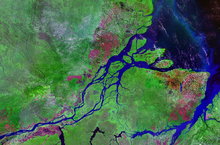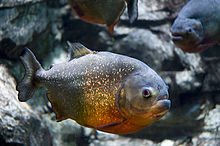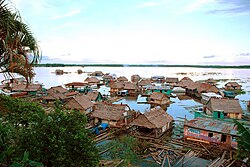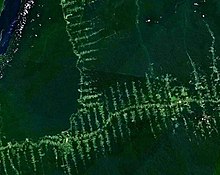The Amazon River Can Be Found on Which Continent?
Coordinates: 2°18′35″S 54°53′17″W / 2.3096°South 54.8881°West / -2.3096; -54.8881

Amazon River Bowl (the southern Guianas, non marked on this map, are a role of the basin)

The rima oris of the Amazon River
The Amazon basin is the function of S America drained by the Amazon River and its tributaries. The Amazon drainage basin covers an expanse of most 6,300,000 kmtwo (two,400,000 sq mi), or nearly 35.5 percent of the South American continent. It is located in the countries of Bolivia, Brazil, Colombia, Ecuador, , Guyana, Peru, Suriname, and Venezuela.[1]
Most of the bowl is covered past the Amazon rainforest, also known every bit Amazonia. With a 5.five one thousand thousand kmii (two.1 million sq mi) area of dumbo tropical forest, this is the largest rainforest in the earth.
Geography [edit]
The Amazon River begins in the Andes Mountains at the westward of the basin with its main tributary the Marañón River and Apurimac River in Republic of peru. The highest betoken in the watershed of the Amazon is the second biggest peak of Yerupajá at half dozen,635 metres (21,768 ft).
With a length of about 6,400 km (iv,000 mi) before it drains into the Atlantic Ocean, information technology is 1 of the two longest rivers in the world. A team of scientists has claimed that the Amazon is longer than the Nile,[ii] only argue about its exact length continues.[3]
The Amazon system transports the largest volume of water of any river system, bookkeeping for about xx% of the total water carried to the oceans by rivers.
Some of the Amazon rainforests are deforested considering of an increase in cattle ranches and soybean fields.
The Amazon bowl formerly flowed west to the Pacific Ocean until the Andes formed, causing the basin to flow eastward towards the Atlantic Ocean.[4]
Politically the basin is divided into the Peruvian Legal Amazonia, Brazilian Legal Amazônia, the Amazon region of Republic of colombia and parts of Bolivia, Ecuador and the Venezuelan state of Amazonas.
Plant life [edit]

Aerial view of function of the Amazon rainforest.
Plant growth is quite dense and its multifariousness of animal inhabitants is comparatively high due to the heavy rainfall and the dense and extensive evergreen and coniferous forests. Trivial sunlight reaches the ground due to the dumbo roof canopy by plants. The ground remains nighttime and damp and simply shade-tolerant vegetation volition abound here. Orchids and bromeliads exploit copse and other plants to get closer to the sunlight. They abound hanging onto the branches or tree trunks with aerial roots, not as parasites but as epiphytes. Species of tropical copse native to the Amazon include Brazil nut, rubber tree and Assai palm.[5] [vi]
Wildlife [edit]

Mammals [edit]
More than one,400 species of mammals are plant in the Amazon, the bulk of which are species of bats and rodents. Its larger mammals include the jaguar, ocelot, capybara, puma and S American tapir.
Birds [edit]
About 1500 bird species inhabit the Amazon bowl.[7] The biodiversity of the Amazon and the sheer number of diverse bird species is given by the number of different bird families that reside in these boiling forests. An instance of such would be the cotinga family, to which the Guianan cock-of-the-rock belong. Birds such as toucans, and hummingbirds are also establish here. Macaws are famous for duck gathering by the hundreds along the clay cliffs of the Amazon River. In the western Amazon hundreds of macaws and other parrots descend to exposed river banks to consume clay on an almost daily basis,[8] the exception being rainy days.[nine]
Reptiles [edit]
The greenish anaconda inhabits the shallow waters of the Amazon and the emerald tree boa and boa constrictor live in the Amazonian tree tops.
Many reptiles species are illegally collected and exported for the international pet trade. Live animals are the fourth largest commodity in the smuggling industry after drugs, diamonds and weapons.[x]
Amphibians [edit]
More than 1,500 species of amphibians swim and are found in the Amazon. Unlike temperate frogs which are mostly express to habitats well-nigh the h2o, tropical frogs are most abundant in the trees and relatively few are found virtually bodies of water on the forest floor. The reason for this occurrence is quite simple: frogs must ever keep their skin moist since virtually half of their respiration is carried out through their skin. The loftier humidity of the rainforest and frequent rainstorms gives tropical frogs infinitely more than freedom to move into the trees and escape the many predators of rainforest waters. The differences between temperate and tropical frogs extend beyond their habitat.

Waterlife [edit]
Near ii,500 fish species are known from the Amazon bowl and it is estimated that more than than i,000 additional undescribed species exist.[eleven] This is more than any other river bowl on Earth, and Amazonia is the center of variety for Neotropical fishes.[12] About 45% (more than 1,000 species) of the known Amazonian fish species are endemic to the basin.[13] The remarkable species richness can in office be explained by the large differences betwixt the various parts of the Amazon bowl, resulting in many fish species that are endemic to small regions. For instance, brute in clearwater rivers differs from brute in white and blackwater rivers, animate being in slow moving sections show distinct differences compared to that in rapids, animate being in small streams differ from that in major rivers, and fauna in shallow sections show distinct differences compared to that in deep parts.[14] [fifteen] [16] By far the about diverse orders in the Amazon are Characiformes (43% of full fish species in the Amazon) and Siluriformes (39%), only other groups with many species include Cichlidae (6%) and Gymnotiformes (3%).[11]
In addition to major differences in behavior and ecology, Amazonian fish vary extensively in form and size. The largest, the arapaima and piraiba can achieve 3 m (9.viii ft) or more than in length and up to 200 kg (440 lb) in weight, making them some of the largest strict freshwater fish in the world.[17] [18] The bull shark and common sawfish, which have been recorded far up the Amazon, may accomplish even greater sizes, but they are euryhaline and oft seen in marine waters.[19] [twenty] In contrast to the giants, there are Amazonian fish from several families that are less than 2 cm (0.viii in) long. The smallest are probable the Leptophilypnion sleeper gobies, which do not surpass one cm (0.4 in) and are among the smallest fish in the world.[21]
The Amazon supports very large fisheries, including well-known species of large catfish (such as Brachyplatystoma, which perform long breeding migrations upwardly the Amazon), arapaima and tambaqui, and is also abode to many species that are important in the aquarium merchandise, such as the oscar, discus, angelfish, Corydoras catfish and neon tetra.[xi] Although the true danger they represent oft is greatly exaggerated, the Amazon basin is home to several feared fish species such as piranhas (including the famous ruby-bellied), electric eel, river stingrays and candiru.[22]
Several cavefish species in the genus Phreatobius are plant in the Amazon, as is the cavern-dwelling house Astroblepus pholeter in the far western part of the basin (Andean region).[23] The Tocantins bowl, arguably not part of the Amazon basin, has several other cavefish species.[23] The deeper role of the major Amazonian rivers are always dark and a few species have adaptions similar to cavefish (reduced pigment and eyes). Amid these are the knifefish Compsaraia and Orthosternarchus, some Cetopsis whale catfish (especially C. oliveirai), some Xyliphius and Micromyzon banjo catfish,[24] and the loricariid catfish Loricaria spinulifera, 50. pumila, Peckoltia pankimpuju, Panaque bathyphilus and Panaqolus zero (these five as well occur in "normal" forms of shallower waters).[25] [26] [27] The perchance most unusual habitat used by Amazonian fish is land. The splash tetra is famous for laying its eggs on plants higher up h2o, keeping them moist past continuously splashing on them,[28] the Southward American lungfish tin survive clandestine in a mucous cocoon during the dry flavor,[29] some small rivulid killifish tin can jump over land between water sources (sometimes moving relatively long distances, fifty-fifty uphill) and may deliberately leap onto country to escape aquatic predators,[xxx] [31] and an undescribed species of worm-like Phreatobius catfish lives in waterlogged leaf litter near (not in) streams.[32] [33]
Some of the major fish groups of the Amazon bowl include:[22]
- Order Gymnotiformes: Neotropical electrical fishes
- Order Characiformes: characins, tetras and relatives
- Family unit Potamotrygonidae: river stingrays
- Family Arapaimidae: bonytongues
- Family Loricariidae: suckermouth catfishes
- Family Callichthyidae: armored catfishes
- Family Pimelodidae: pimelodid catfishes
- Family Trichomycteridae: pencil catfishes
- Family Auchenipteridae: driftwood catfishes
- Subfamily Cichlinae: pike cichlids, peacock cichlids and relatives
- Subfamily Geophaginae: Eartheaters and Neotropical dwarf cichlid
- Subfamily Poeciliinae: guppies and relatives
Insects [edit]
More 90% of the animal species in the Amazon are insects,[34] of which about 40% are beetles (Coleoptera constituting almost 25% of all known types of creature life-forms.)[35] [36] [37]
Whereas all of Europe has some 321 butterfly species, the Manú National Park in Peru (4000 hectare-survey) has 2300 species, while Tambopata National Reserve (5500 hectare-survey) has at least 1231 species.
Climate and seasons [edit]
The Amazon River bowl has a low-h2o flavor, and a moisture season during which, the rivers flood the adjacent, low-lying forests. The climate of the basin is generally hot and humid. In some areas, however, the winter months (June–September) can bring cold snaps, fueled by Antarctic winds traveling along the next mountain range. The average annual temperature is effectually 25-degree and 28 degree Celsius with no stardom between summer and wintertime flavour.
Human lifestyle [edit]

Amazonia is sparsely populated. There are scattered settlements inland, but most of the population lives in a few larger cities on the banks of the Amazon and other major rivers, such equally in Iquitos - Loreto in Republic of peru, Manaus-Amazonas State, and Belém, Pará. In many regions, the forest has been cleared for soya bean plantations and ranching (the almost extensive non-wood use of the land); some of the inhabitants harvest wild rubber latex, and Brazilian nuts. This is a class of extractive farms, where the trees are not cutting downwards. These are relatively sustainable operations in contrast to lumbering or agriculture dependent on clearing the rainforest. The people live in thatched houses shaped liked beehives. They also build flat-like houses called "Maloca", with a steeply slanting roof.
Languages [edit]
The well-nigh widely spoken languages in the Amazon are Portuguese and Spanish. On the Brazilian side, Portuguese is spoken by at least 98% of the population, whilst in the Spanish-speaking countries, a large number of speakers of indigenous languages are present, though Spanish is predominant.
There are hundreds of native languages yet spoken in the Amazon, most of which are spoken past simply a handful of people, and thus are critically endangered.
Indigenous peoples [edit]
As nosotros know 80% percentage of the basin is covered with Amazon rainforest thus, it's clear that many tribal group besides lived here. It is estimated 400 or more than than 400 tribal groups lived hither from hundreds of year with their ain civilisation, language, and lifestyle it is home to 1 million Indian tribe likewise. Today full population of Amazon basin is 1.5 million distributed and 400 tribal groups. In that location are 100 uncontacted tribes. The largest organization fighting for the indigenous peoples in this surface area is COICA. It is a supra arrangement encompassing all indigenous rights organizations working in the Amazon basin area, and covers the people living in several countries.
River commerce [edit]
The river is the principal path of transportation for people and produce in the regions, with ship ranging from balsa rafts and dugout canoes to manus built wooden river craft and mod steel hulled arts and crafts.
Agriculture [edit]
Seasonal floods excavate and redistribute nutrient-rich silt onto beaches and islands, enabling dry out-season riverside agriculture of rice, beans, and corn on the river's shoreline without the addition of fertilizer, with boosted slash and burn agriculture on higher floodplains. Fishing provides boosted food year-round, and costless-range chickens need trivial or no food across what they can forage locally. Charcoal made largely from forest and shoreline deadfall is produced for apply in urban areas. Exploitation of bushmeat, particularly deer and turtles is common.

Deforestation and increased road-edifice bring human inroad upon wild areas, increased resource extraction and threats to biodiversity.
Extensive deforestation, especially in Brazil, is leading to the extinction of known and unknown species, reducing biological multifariousness and adversely impacting soil, h2o, and air quality. A last part of the deforestation process is the large-scale production of charcoal for industrial processes such every bit steel manufacturing. Soils within the region are generally shallow and cannot be used for more than a few seasons without the addition of imported fertilizers and chemicals.
Global ecological role / Part for climate change [edit]
"The Amazon is a disquisitional cushion of carbon of carbon dioxide, a greenhouse gas produced mainly past volcanoes the Amazon's role is as a sink, draining heat-trapping carbon dioxide from the temper. Currently, the earth is emitting around 40 billion tons of CO2 into the atmosphere every twelvemonth. The Amazon absorbs two billion tons of CO2 per twelvemonth (or v% of annual emissions), making it a vital role of preventing climatic change."[38]
"Amazon biodiversity also plays a disquisitional role as role of global systems, influencing the global carbon cycle and thus climatic change, besides as hemispheric hydrological systems, serving as an of import anchor for Southward American climate and rainfall.It too produce 20% oxygen of the earth"[39]
See besides [edit]
- Amazon biome
- Amazon Conservation Association
- Amazon Conservation Squad
- Deforestation of the Amazon rainforest
- Jaguars s of the Amazon River
- Llanos de Moxos
- Llanos de Moxos (archæology)
- Panthera onca onca
- Peruvian jaguar
- Sustainable Bolivia
- Ucayali Peneplain
References [edit]
- ^ Goulding, M., Barthem, R. B. and Duenas, R. (2003). The Smithsonian Atlas of the Amazon, Smithsonian Books ISBN 1-58834-135-6
- ^ Roach, John (18 June 2007). "Amazon Longer Than Nile River, Scientists Say". National Geographic.
- ^ Raymond E. Crist; Alarich R. Schultz; James J. Parsons (16 March 2018). "Amazon River". Encyclopædia Britannica. Retrieved 21 August 2018.
- ^ "Amazon river flowed into the Pacific millions of years agone". Mongabay. 24 October 2006. Archived from the original on 3 January 2013. Retrieved 8 June 2014.
- ^ Amazon, Plants. "Amazon plants and trees".
- ^ "The Coolest Plants in the Amazon Rainforest". Rainforest Cruises.
- ^ Butler, Rhett (31 July 2012). "Diversities of Image". Mongabay.com . Retrieved twenty December 2014.
- ^ Munn, C. A. 1994. Macaws: winged rainbows. National Geographic, 185, 118–140.
- ^ Brightsmith D. J. (2004). "Effects of weather on parrot geophagy in Tambopata, Peru". Wilson Bulletin. 116 (2): 134–145. doi:10.1676/03-087b. S2CID 83509448.
- ^ "Amazon Reptiles". Mongabay.com.
- ^ a b c Junk, West.J.; M.G.M. Soares; P.B. Bayley (2007), "Freshwater fishes of the Amazon River Basin: their biodiversity, fisheries, and habitats", Aquatic Ecosystem Health and Direction, 10 (2): 153–173, doi:x.1080/14634980701351023, S2CID 83788515
- ^ James Southward. Albert; Roberto E. Reis (2011). Historical Biogeography of Neotropical Freshwater Fishes. p. 308. ISBN978-0-520-26868-5.
- ^ Reis R.E.; Albert J.S.; Di Dario F.; Mincarone K.Yard.; Petry P.; Rocha L.A. (2016). "Fish biodiversity and conservation in South America". Journal of Fish Biology. 89 (1): 12–47. doi:ten.1111/jfb.13016. PMID 27312713.
- ^ Stewart D. J.; Ibarra M. (2002). "Comparison of Deep-River and Adjacent Sandy-Beach Fish Assemblages in the Napo River bowl, Eastern Ecuador". Copeia. 2002 (ii): 333–343. doi:10.1643/0045-8511(2002)002[0333:codraa]2.0.co;2.
- ^ Mendonça, F. P., W. E. Magnusson, J. Zuanon and C. G. Taylor. (2005) Relationships betwixt habitat characteristics and fish assemblages in small streams of Key Amazonia. Copeia 2005(4): 751–764
- ^ Duncan, West.P.; and Fernandes, K.Due north. (2010). Physicochemical label of the white, black, and clearwater rivers of the Amazon Basin and its implications on the distribution of freshwater stingrays (Chondrichthyes, Potamotrygonidae). PanamJAS five(iii): 454–464.
- ^ Froese, Rainer; Pauly, Daniel (eds.) (2017). "Arapaima gigas " in FishBase. September 2022 version.
- ^ Froese, Rainer; Pauly, Daniel (eds.) (2017). "Brachyplatystoma filamentosum " in FishBase. September 2022 version.
- ^ Froese, Rainer; Pauly, Daniel (eds.) (2017). "Carcharhinus leucas " in FishBase. September 2022 version.
- ^ Froese, Rainer; Pauly, Daniel (eds.) (2017). "Pristis pristis " in FishBase. September 2022 version.
- ^ Roberts, T.R. (2013). "Leptophilypnion, a new genus with two new species of tiny primal Amazonian gobioid fishes (Teleostei, Eleotridae)". Aqua, International Periodical of Ichthyology. 19 (2): 85–98.
- ^ a b van der Sleen P, Albert JS, eds. (2017). Field Guide to the Fishes of the Amazon, Orinoco, and Guianas. Princeton Academy Press. ISBN978-0691170749.
- ^ a b Romero, Aldemaro, ed. (2001). The Biology of Hypogean Fishes. Developments in environmental biology of fishes. Vol. 21. ISBN978-1402000768.
- ^ Fenolio, Danté (2016). Life in the Dark: Illuminating Biodiversity in the Shadowy Haunts of Planet World. Johns Hopkins University Press. ISBN978-1421418636.
- ^ Lujan, Nathan. K.; Chamon, Carine. C. (2008). "Two new species of Loricariidae (Teleostei: Silurifomes) from chief channels of the upper and middle Amazon Basin, with word of deep water specialization in loricariids". Ichthyological Exploration of Freshwaters. nineteen: 271–282.
- ^ Thomas, Yard.R.; 50.H.R. Py-Daniel (2008). "3 new species of the armored catfish genus Loricaria (Siluriformes: Loricariidae) from river channels of the Amazon basin". Neotrop. Ichthyol. 6 (3): 379–394. doi:ten.1590/S1679-62252008000300011.
- ^ Cramer, C.A.; L.H.R. Py-Daniel (2015). "A new species of Panaqolus (Siluriformes: Loricariidae) from the rio Madeira bowl with remarkable intraspecific color variation". Neotrop. Ichthyol. xiii (3): 461–470. doi:x.1590/1982-0224-20140099.
- ^ Howard, B.C. (27 September 2013). Fish That Lay Eggs Out of the H2o: Freshwater Species of the Week. National Geographic. Retrieved xxx Apr 2017.
- ^ SeriouslyFish. "Lepidosiren paradoxa". Retrieved 30 April 2017.
- ^ Vermeulen, F. "The genus Rivulus". itrainsfishes.internet. Retrieved 6 May 2017. [ permanent expressionless link ]
- ^ Turko, A.J.; P.A. Wright (2015). "Evolution, ecology and physiology of amphibious killifishes (Cyprinodontiformes)". Journal of Fish Biology. 87 (iv): 815–835. doi:10.1111/jfb.12758. PMID 26299792.
- ^ Planet Catfish. "Cat-eLog: Heptapteridae: Phreatobius: Phreatobius sp. (1)". Planet Catfish. Retrieved 30 Apr 2017.
- ^ Henderson, P.A.; I. Walker (1990). "Spatial organization and population density of the fish customs of the litter banks within a primal Amazonian blackwater stream". Periodical of Fish Biology. 37 (three): 401–411. doi:10.1111/j.1095-8649.1990.tb05871.x.
- ^ "Amazon Insects". Mongabay.com.
- ^ Powell (2009)
- ^ Rosenzweig, Michael L. (1995). Species Diverseness in Space and Time. Cambridge University Press. ISBN978-0-521-49952-i.
- ^ Hunt, T.; Bergsten, J.; Levkanicova, Z.; Papadopoulou, A.; John, O. St.; Wild, R.; Hammond, P. Yard.; Ahrens, D.; Balke, M.; Caterino, M. S.; Gomez-Zurita, J.; Ribera, I.; Barraclough, T. Thou.; Bocakova, M.; Bocak, L.; Vogler, A. P.; et al. (2007). "A Comprehensive Phylogeny of Beetles Reveals the Evolutionary Origins of a Superradiation". Science. 318 (5858): 1913–1916. Bibcode:2007Sci...318.1913H. doi:10.1126/scientific discipline.1146954. PMID 18096805. S2CID 19392955.
- ^ https://phys.org/news/2019-08-office-amazon-global-climate.amp ; 2022 January. 12
- ^ https://world wide web.worldbank.org/en/news/feature/2019/05/22/why-the-amazons-biodiversity-is-critical-for-the-globe ; 2022 January. 12
Further reading [edit]
- Dematteis, Lou; Szymczak, Kayana (June 2008). Crude Reflections/Cruda Realidad: Oil, Ruin and Resistance in the Amazon Rainforest. City Lights Publishers. ISBN978-0-87286-472-half-dozen.
- Acker, Antoine. "Amazon" (2015). University Bielefeld – Center for InterAmerican Studies.
External links [edit]
- Herndon and Gibbon Lieutenants U.s. Navy The Commencement North American Explorers of the Amazon Valley, by Historian Normand E. Klare. Actual Reports from the explorers are compared with present Amazon basin weather condition.
- Scientists find Evidence Discrediting Theory Amazon was Virtually Unlivable by The Washington Post
- "The Course of the River of the Amazons, Based on the Account of Christopher d'Acugna" from 1680
manifoldscerfumfor57.blogspot.com
Source: https://en.wikipedia.org/wiki/Amazon_basin
0 Response to "The Amazon River Can Be Found on Which Continent?"
Post a Comment